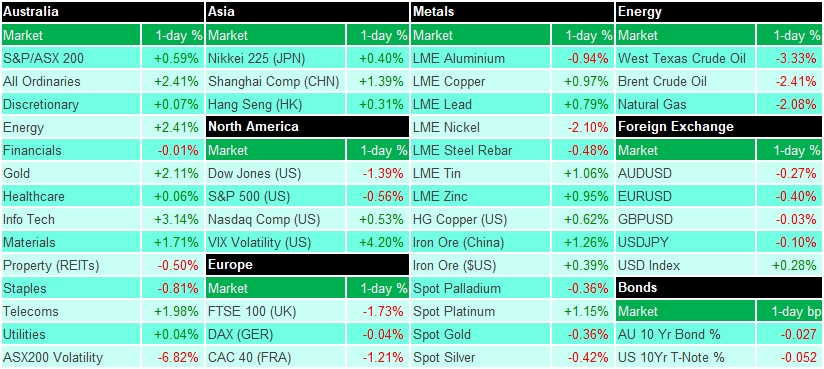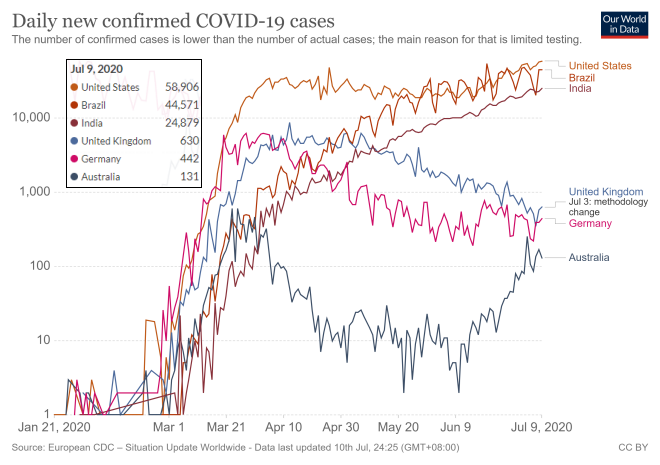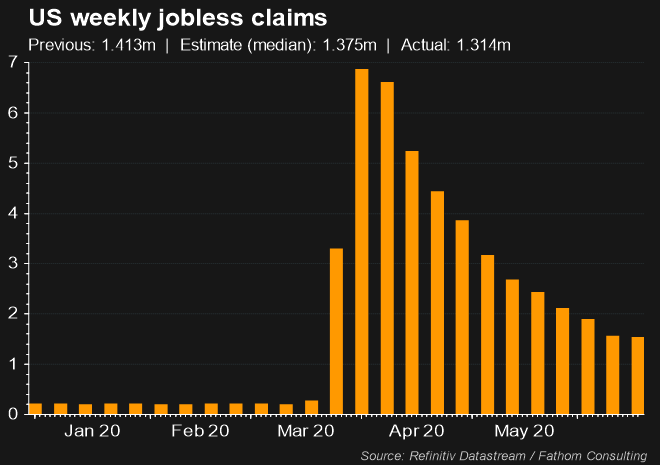A snapshot of overnight moves and a look to the upcoming Australasian session for 10 July.
Market Moves

Wrap
Overnight, US markets logged their seventh consecutive session of alternating gains and losses. The benchmark S&P500 fell 0.56%, and the Dow Jones Industrial Index was down 1.4%. The NASDAQ bucked the trend however, closing up an impressive 0.53%. This was another record high. The so-called 'fear gauge', the volatility index (VIX), rose 4.2%.
If not for strong gains in bellwethers Apple (+4%), Cisco (+1.9%), Microsoft (0.7%) and Walmart (+2.7%) the result on US indices would have been far worse.
US investor sentiment continues to be dogged by the rising covid-19 daily confirmed case count. At over 58k per day now, cases remain at a record since the start of the crisis.

Weekly jobless claims data showed fewer than expected Americans had claimed for unemployment benefits (see chart and report below in
Macroeconomics), and this likely helped stabilise the losses.
With the first earnings season since the worst of the pandemic-induced shutdowns due to start next week, few investors are prepared to make big bets on the long side at the moment.
Metals prices on the LME showed their resilience. Aluminium (-0.94%), Nickel (-2.1%), and Steel (-0.48% were lower, whilst Copper (+0.97%), Lead (+0.79%), Tin (+1.1%) and Zinc (+0.95%) each managed to push their recent advantage.
Iron ore prices also continued their strong recent form, rising 1.3% on the Chinese Dalian exchange, and 0.4% in the Singapore-based $US price.
Gold couldn't capitalise on the stock market's nerves, edging 0.36% lower, with spot gold now trading at US$1803.74 an ounce.
The energy complex was hit the hardest, as fears for a possible renewed round of lockdowns in the World's largest economy plagued investor confidence. Crude oil tumbled 3.3%, once again losing the $40 handle to close at $39.58. Brent crude fell 2.4%, while natural gas was 2.1% lower.
The ASX200 Share Price Index closed the evening session 24 points lower at 5896. That's a 60 point discount to yesterday's ASX 200 close of 5956. Given the typical recent 20-30 point discount on the SPI, this implies that the ASX 200 should trade roughly 0.5-1.0% lower at the open.
AU Companies
Afterpay (APT)
The best performer from the ASX 200 yesterday was buy now-pay later segment leader Afterpay which popped another 11.3% after Morgan Stanley upgraded its rating for the stock from equal-weight to overweight. MS also increased their target price for APT from $36 to $101.
Netwealth (NWL)
The next best performer from yesterday was Netwealth (NWL), who gained 9.2% after it reported funds under management grew 35% for FY20, and also reported record growth in net inflows. Importantly, the June quarter showed a big bounce back in inflows following March's covid-19 pandemic affected results.
AUB
Today, investors will focus on a trading update from insurance broker AUB who reported that underlying NPAT for FY20 would most likely be towards the top of the previously announced guidance range of $52m-$53m. This represents growth of 12-14% compared to FY19.
Polynovo (PNV)
Medical device company, Polynovo (PNV) reported that FY20 hospital accounts in the US were up 67%, and the company had achieved record sales. June quarter sales were up 33% on March.
Chairman, David Williams said, "While FY20 sales will show impressive growth over FY19, the sales run-rate is more impressive and should be a better indicator of the near-term future."
Bell Financial Group (BFG)
Also updating the market, is stockbroker Bell Financial Group (BFG). The broker it expects to report a first half FY20 EBIT of approximately $23.5 million. This is an increase of around 5% on the previous corresponding period.
Rio Tinto (RIO)
In London broker moves, Goldman Sachs downgraded mining heavyweight Rio Tinto (RIO) from buy to neutral based upon current valuations.
Macro Economy
On the economic data front, local markets will look to the release of wholesale inflation data in the US tonight. The producer price index (PPI) is expected to show that wholesale prices have remained relatively stable in the month of June, rising by only 0.1%.
Below is a brief summary of the key macroeconomic data developments for the last 24 hours.
USA

US weekly jobless claims fell to their lowest level since the start of the covid-19 pandemic. 1.314m Americans filed for unemployment benefits over the past week, down from 1.413m the previous week, and better than market forecasts of 1.375m.
Despite the improvement, weekly jobless claims remain more than double the level seen during the Global Financial Crisis.
Back